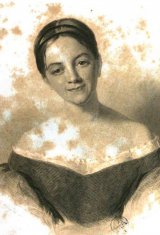Analysis of The Rush-Bearing At Ambleside
Letitia Elizabeth Landon 1802 (Chelsea) – 1838 (Cape Coast)
Summer is come, with her leaves and her flowers—
Summer is come, with the sun on her hours;
The lark in the clouds, and the thrush on the bough,
And the dove in the thicket, make melody now.
The noon is abroad, but the shadows are cool
Where the green rushes grow in the dark forest pool.
We seek not the hedges where violets blow,
There alone in the twilight of ev'ning we go;
They are love-tokens offered, when heavy with dew,
To a lip yet more fragrant—an eye yet more blue.
But leave them alone to their summer-soft dream—
We seek the green rushes that grow by the stream.
Away from the meadow, although the long grass
Be filled with young flowers that smile as we pass;
Where the bird's eye is bright as the sapphires that shine
When the hand of a beauty is decked from the mine.
We want not their gems, and we want not their flowers.
But we seek the green rush in the dark forest bowers.
The cowslip is ringing its fairy-like chime,
Sweet bells, by whose music Titania keeps time;
The rose-bush is covered with cups that unfold
Their petals that tremble in delicate gold.
But we seek not their blossoms in garlands to blend,
We seek the green rush where the willow-trees bend.
The green rush, the green rush, we bear it along
To the church of our village with triumph and song;
We strew the cold chancel, and kneel on it there,
While its fresh odours rise with our voices in prayer.
Hark the peal from the old tower in praise of it rings,
Let us seek the green rush by the deep woodland springs.
In the olden time, when the churches were strewn with rushes, the ceremony of changing them was a yearly religious festival. The custom, once universal, now lingers only in some of the remote northern districts. There, bunches of rushes, gaily ornamented, attended by banners and music, are still borne in triumph by the young people of the village. Last remains of that pastoral poetry which once characterised "merrie England."
| Scheme | AABBCC DDEEFF GGHHAA IIJJKK LLMMNN X |
|---|---|
| Poetic Form | |
| Metre | 10111010010 10111011010 01001001101 001001011001 0110110111 101101001101 11101011001 10100111111 111101011011 101111011111 11101111011 11011011101 011011011 11111011111 1011111010011 101101011101 111110111110 1110110011010 01011011011 11111001011 01111011101 11011001001 11111100111 1101110111 01101111101 1011101011001 1101101111 111111101001 1011011001111 11101110111 00101101001110010011011010010100010101011010011001101011011010100010110010111010101101010101111001001111010 |
| Closest metre | Iambic heptameter |
| Characters | 1,919 |
| Words | 355 |
| Sentences | 16 |
| Stanzas | 6 |
| Stanza Lengths | 6, 6, 6, 6, 6, 1 |
| Lines Amount | 31 |
| Letters per line (avg) | 49 |
| Words per line (avg) | 11 |
| Letters per stanza (avg) | 255 |
| Words per stanza (avg) | 59 |
Font size:
Citation
Use the citation below to add this poem analysis to your bibliography:
Style:MLAChicagoAPA
"The Rush-Bearing At Ambleside" Poetry.com. STANDS4 LLC, 2024. Web. 26 May 2024. <https://www.poetry.com/poem-analysis/25726/the-rush-bearing-at-ambleside>.


Discuss this Letitia Elizabeth Landon poem analysis with the community:
Report Comment
We're doing our best to make sure our content is useful, accurate and safe.
If by any chance you spot an inappropriate comment while navigating through our website please use this form to let us know, and we'll take care of it shortly.
Attachment
You need to be logged in to favorite.
Log In